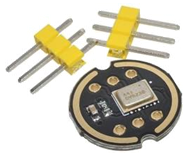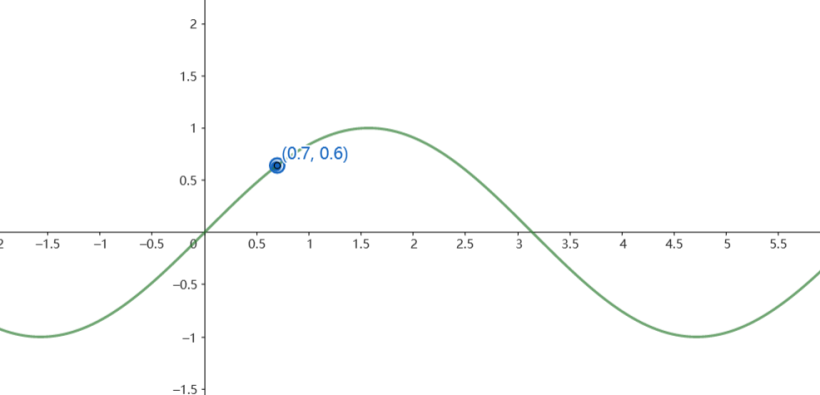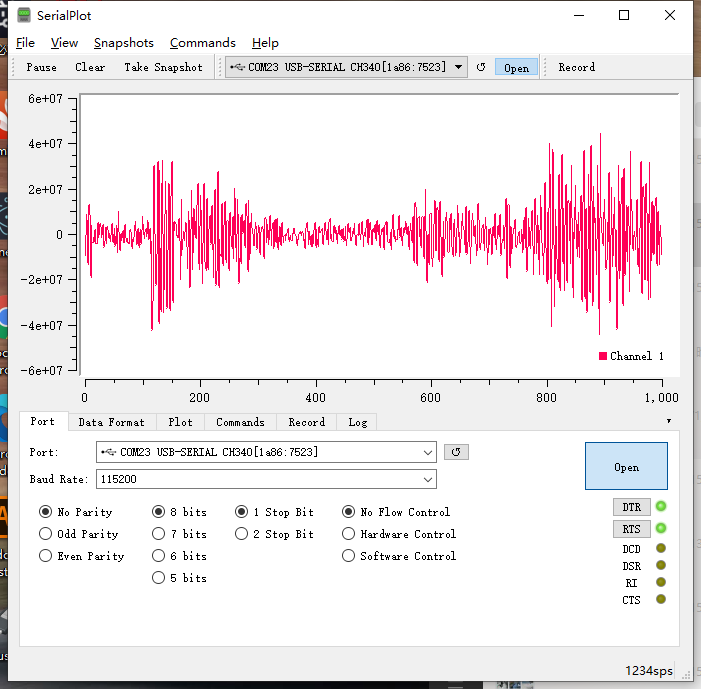

OpenHarmony轻量化系统声音收录
source link: https://www.51cto.com/article/749328.html
Go to the source link to view the article. You can view the picture content, updated content and better typesetting reading experience. If the link is broken, please click the button below to view the snapshot at that time.

OpenHarmony轻量化系统声音收录

前一阵子想着语音识别作为物联网不可或缺的一部分,前提是获取到语音的声音数据。对于声音收录数字化,stm32有很多现成的样例,而OpenHarmony方面较少该方面的资料。便想着在OpenHarmony实现接收INMP441麦克风模块。本次实现通过I2S接收INMP441模块的PCM数据。

- OpenHarmony-3.1
- 润和hispark_pegasus Hi3861开发板
- DevEco Device Tool
- SerialPlot
- INMP441麦克风模块
声音数字化
生活中的声音是通过一定介质传播的波、主要由振幅和频率两个指标来描述。
声音数字化:麦克风将声音以量化位数将声音数字化,常见的量化位深有16bit、24bit、32bit,其意义就是将每个采样点用多少位表示声音振幅的范围,其位深越大音质越好。麦克风再根据采样率进行采集声音,采样率的意思就是1秒中采集声音的次数,采样率越高音质越好。还决定音质的便是声道数,使用双声道可以大大丰富声音的表现力,但随之而来的便是数据量的翻倍。
现实生活中的声音信号是如下图般的波形图,但是我们的计算机中只能保存数值。于是我们将波形图量化,使用一个个整数数据记录声音。

本次使用的INMP441是一个数字麦克风,即本身包含了ADC,传递进来的数据是数字量。得到的数据便是直接的PCM编码格式的数据,若想生成WAV文件,只需要生成一个wav head来标识即可。
// 生成wav header,32bit 位深
void wavHeader(byte* header, int wavSize){ // 数字小端格式,字符大端格式
header[0] = 'R';
header[1] = 'I';
header[2] = 'F';
header[3] = 'F';
unsigned int fileSize = wavSize + headerSize - 8;
header[4] = (byte)(fileSize & 0xFF); // file size, 4byte integer
header[5] = (byte)((fileSize >> 8) & 0xFF);
header[6] = (byte)((fileSize >> 16) & 0xFF);
header[7] = (byte)((fileSize >> 24) & 0xFF);
header[8] = 'W';
header[9] = 'A';
header[10] = 'V';
header[11] = 'E';
header[12] = 'f';
header[13] = 'm';
header[14] = 't';
header[15] = ' ';
header[16] = 0x10; // length of format data = 16, 4byte integer
header[17] = 0x00;
header[18] = 0x00;
header[19] = 0x00;
header[20] = 0x01; // format type:1(PCM), 2byte integer
header[21] = 0x00;
header[22] = 0x01; // channel number:1, 2byte integer
header[23] = 0x00;
header[24] = 0x80; // sample rate:16000=0x00003E80, 4byte integer
header[25] = 0x3E;
header[26] = 0x00;
header[27] = 0x00;
header[28] = 0x00; // SampleRate*BitPerSample*ChannelNum/8=16000*32*1/8=64000=0x0000FA00, 4byte integer
header[29] = 0xFA;
header[30] = 0x00;
header[31] = 0x00;
header[32] = 0x04; // BitPerSample*ChannelNum/8 = 4, 2byte integer
header[33] = 0x00;
header[34] = 0x20; // BitPerSample:32 = 0x0020, 2byte integer
header[35] = 0x00;
header[36] = 'd';
header[37] = 'a';
header[38] = 't';
header[39] = 'a';
header[40] = (byte)(wavSize & 0xFF);
header[41] = (byte)((wavSize >> 8) & 0xFF);
header[42] = (byte)((wavSize >> 16) & 0xFF);
header[43] = (byte)((wavSize >> 24) & 0xFF);
}本次实验只用到了以下四个I2S的针脚
- SCK(CK):串行时钟,由主机产生的时钟线,用于控制每位数据的传输时序,SCK频率= 声道数 采样频率 * 采样位数*,在OpenHarmony上被定义为BCLK口
- SD:I2S数据线,从机通过此发送数据给主机,在OpenHarmony上被定义为RX口
- WS:声道选择线,由主机发送给从机,从机根据此判断发送左声道还是右声道。低电平为左声道,高电平为右声道。
- L/R:左右声道选择线,指定此从机为左声道还是右声道。低电平为左声道,高电平为右声道。
INMP441 | Hi3861 |
根据需求接GND或3V3 | |
查看音频波形
Hi3861接收到了麦克风模块上传的音频数据,我们可以利用串口将音频数据发送到电脑,电脑使用串口绘画工具SerialPlot查看音频波形,该工具的使用方法和使用其他串口工具相似,网上也有许多使用教程,这里就不再详细阐述。

- 初始化IO口
- 配置I2S(采样率为8KHz,量化位数为24bit)
- 初始化I2S
- 读取I2S数据,OpenHarmony的读取函数得到的数据就是24bit数字量;无需像stm32需要读取的数据是byte类型,然后再拼接。
数据将以LRLR分布,即是一个左声道数据,一个右声道数据分布
若是只使用到单声道,也是LRLR分布,另外一个声道数据为0
#include <stdio.h>
#include <unistd.h>
#include "ohos_init.h"
#include "cmsis_os2.h"
#include "iot_gpio.h"
#include "iot_pwm.h"
#include "iot_i2c.h"
#include "iot_errno.h"
#include "hi_dma.h"
#include "hi_types_base.h"
#include "hi_i2s.h"
#include "hi_io.h"
void i2s_init_demo(void)
{
hi_u32 ret;
//初始化IO口
IoTGpioInit(HI_IO_NAME_GPIO_7);
IoTGpioInit(HI_IO_NAME_GPIO_8);
IoTGpioInit(HI_IO_NAME_GPIO_11);
IoTGpioInit(HI_IO_NAME_GPIO_10);
hi_io_set_func(HI_IO_NAME_GPIO_7, HI_IO_FUNC_GPIO_7_I2S0_BCLK);
hi_io_set_func(HI_IO_NAME_GPIO_8, HI_IO_FUNC_GPIO_8_I2S0_WS);
hi_io_set_func(HI_IO_NAME_GPIO_11, HI_IO_FUNC_GPIO_11_I2S0_RX);
hi_io_set_func(HI_IO_NAME_GPIO_10, HI_IO_FUNC_GPIO_10_I2S0_TX);
ret = hi_i2s_deinit();
//配置I2S,采样率为8KHz,量化位数为24bit
hi_i2s_attribute i2s_cfg = {
.sample_rate = HI_I2S_SAMPLE_RATE_8K,
.resolution = HI_I2S_RESOLUTION_24BIT,
};
if (ret != HI_ERR_SUCCESS)
printf("Failed to deinit i2s!\n");
//初始化
ret = hi_i2s_init(&i2s_cfg);
if (ret != HI_ERR_SUCCESS)
printf("Failed to init i2s!\n");
printf("ret = %d \n", ret);
printf("I2s init succrss!\n");
}
void i2s_main_demo(void)
{
hi_u32 ret;
i2s_init_demo();
sleep(2);
hi_u32 get_buff[100] = {0};
while(1)
{
//读取I2S信息
hi_i2s_read(get_buff, 100, HI_SYS_WAIT_FOREVER);
for (int i = 0; i < 100;i++)
{
printf("%d\n", get_buff[i]);
}
}
}
//demo线程创建
void INMP441TestDemo(void)
{
osThreadAttr_t attr;
attr.name = "INMP441Task";
attr.attr_bits = 0U;
attr.cb_mem = NULL;
attr.cb_size = 0U;
attr.stack_mem = NULL;
attr.stack_size = 10240;
attr.priority = osPriorityNormal;
if (osThreadNew(i2s_main_demo, NULL, &attr) == NULL)
{
printf("[INMP441Task] Falied to create INMP441Task!\n");
}
}
APP_FEATURE_INIT(INMP441TestDemo);static_library("mic_test") {
sources = [
"inmp441_demo.c",
]
include_dirs = [
"//utils/native/lite/include",
"//kernel/liteos_m/components/cmsis/2.0",
"//base/iot_hardware/peripheral/interfaces/kits",
"//device/soc/hisilicon/hi3861v100/hi3861_adapter/hals/communication/wifi_lite/wifiservice",
"//device/soc/hisilicon/hi3861v100/hi3861_adapter/kal",
"//ohos_bundles/@ohos/device_soc_hisilicon/hi3861v100/sdk_liteos/include",
"//device/soc/hisilicon/hi3861v100/sdk_liteos/include"
]
}Recommend
About Joyk
Aggregate valuable and interesting links.
Joyk means Joy of geeK